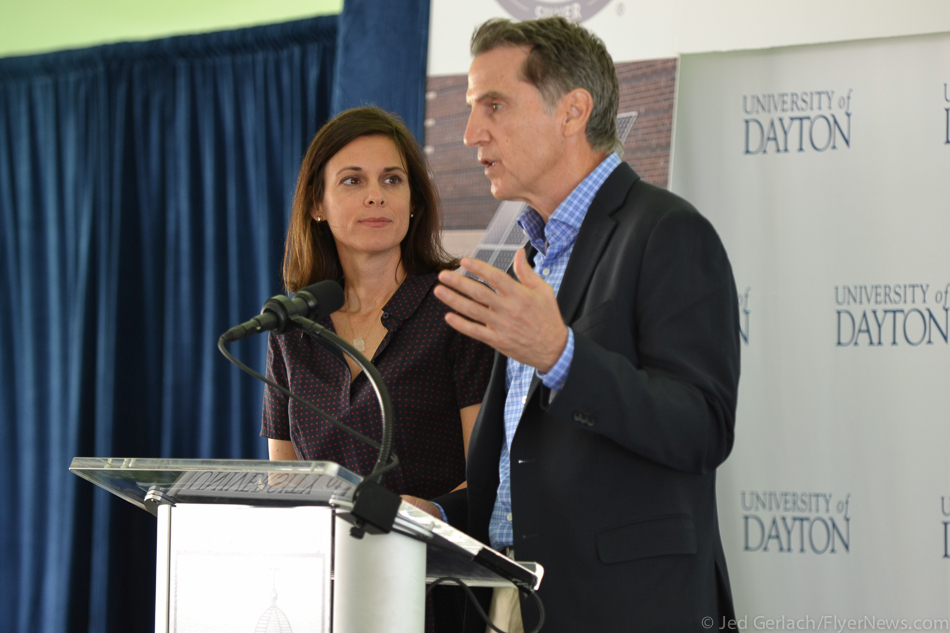Hanleys gift $12.5 million to UD sustainability
By: CC Hutten – Editor-in-Chief & Matthew Worsham – Managing Editor
The University of Dayton just got a lot more green.
The largest single monetary gift in UD’s history will go toward the establishment of the Hanley Sustainability Institute and will support sustainability education across disciplines.
In a Sept. 19 ceremony at Kennedy Union Central Mall, the University of Dayton and the George and Amanda Hanley Foundation announced the foundation’s $12.5 million gift to UD, establishing the university as a national leader for innovation in sustainability education.
MEET THE HANLEYS
George Hanley, a ‘77 business management alumnus and member of the university Board of Trustees, co-created the George and Amanda Hanley Foundation in 1997 alongside his wife, Amanda, who has been dedicated to environmental protection and sustainable solutions for more than 25 years, according the foundation’s website.
George Hanley made his career in the trading industry, joining the MidAmerica Commodity Exchange after graduating from UD, according to his website. After trading at various other exchanges, he founded the Hanley Group in 1986, which was purchased in 2010 by INTL FC Stone and renamed INTL Hanley LLC, where he served as CEO until 2013. He’s still active in the industry, launching Level 5 Trading this year.
Amanda Hanley holds a bachelor’s degree in business management from Northern Illinois University and is a leader in a number of environmental protection organizations including the Natural Resources Defense Council, the Academy for Global Citizenship and Chicago Women in Green and co-founded North Shore Green Women, according to her profile on the Hanley Foundation’s website. She also contributes to The Huffington Post and manages ecowren.net.
According to George Hanley’s website, the Hanley Foundation supports “global and regional initiatives in education, economic empowerment and environmental sustainability.”
WHY THEY DID IT
At the live announcement ceremony, George Hanley said this gift is really about the students.
“It’s about providing the facility for the students to be able to tackle the challenges that our world faces, but also to take advantage of the opportunity that will bring,” he said.
Said Amanda Hanley, “When I went to college, the word ‘sustainability’ didn’t exist. I was really passionate about doing something for the environment, but there was nothing like this. We’ve come so far to be here today, having an institute at a major university.” She continued, “The staff, the faculty, the students … are going to be bringing us the solutions that we desperately need to make this world more sustainable.”
However, Amanda Hanley’s dedication goes far beyond the Foundation’s gift. This summer, UD announced its decision to divest in fossil fuels, according to an Aug. 12 Flyer News article. Amanda Hanley wrote in a July 2 Huffington Post article that, “Catholic teachings have already laid the groundwork for taking climate action … We simply cannot continue business as usual … Ideally, UD’s breakthrough decision will reinvigorate the dialogue in Catholic higher education and serve as roadmap helping others follow suit.”
DEDICATION TO UD
“Sustainability is really a philosophy that stems from our Catholic Marianist mission,” President Dan Curran said in his speech at the live announcement. “It’s about promoting the common good. In this respect the new Hanley Sustainability Institute compliments our commitments in human rights research and education.”
Though living in Winnetka, Illinois, the Hanleys are longtime supporters of the university, with a history of endowments. For example, in 2007 they established The Hanley Trading Center in the university’s School of Business Administration, which gives finance students real world experience and training, and recently supported the Engineers in Technical Humanitarian Opportunities of Service-Learning program, which enables students to travel to developing countries to use their skills to implement sustainable technologies, according to Curran.
They have also supported Dayton Early College Academy, service abroad programs, campus ministry spring break service trips around the country and minority and law fellowships.
“They inspire us to make a difference,” Curran said. “They try to empower others to use their education to change the world.”
In 2000, the Society of Mary gave the university a $10.5 million gift for “scholarships and for Catholic, Marianist academics and activities,” the largest gift in university history before the Hanleys’ gift last week, according to a Sept. 19 article by Dayton Daily News.
According to the UD press release, the university will launch a “comprehensive campaign to raise additional funds from foundations, corporations and other donors to bring total funding for the institute to $25 million.”
WHAT IT MEANS
FOR STUDENTS
The gift will support the new Hanley Sustainability Institute, including initial projects such as an annual national conference, an urban farming project being pursued by students in SEE 401 Sustainability Research course and support for faculty and student research, according to Robert Brecha, Ph.D, a physics and Renewable and Clean Energy Program professor and the coordinator of the Sustainability, Energy and the Environment initiative.
“Beyond those specifics, the Institute will be created and developed as part of a dialogue between all of the involved groups on campus,” Brecha said.
“I believe the Hanleys want to set a signal that sustainability education is key for the future,” Brecha said. “Sustainability initiatives, like SEE and now the creation of The Hanley Sustainability Institute, are a means for students of all majors, across all parts of the university, to learn about and participate in these vital conversations.”
David Fink, a freshman mechanical engineering major and member of the SEE Learning-Living Community, was excited about the announcement.
“It’s really cool that families and businesses are coming together to do this. UD’s really becoming more sustainable, with composting [and participation in] Mission of Mary Farm,” he said. “It’s really great to see the results of your work.”
“Students, in many ways, have been the driving force for this Institute,” Benson said. “The obligation is now on us to carry this vision forward.”


